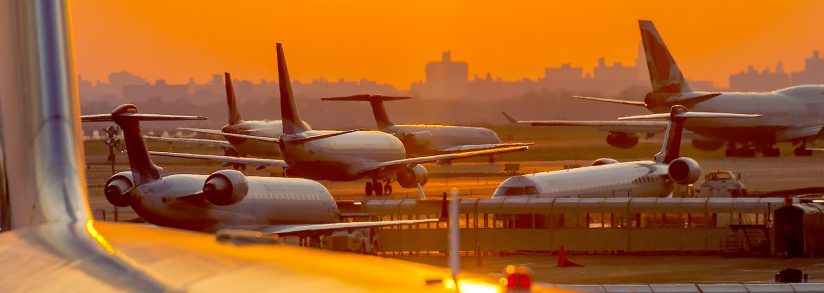
(This article is the first in a series of articles on landmark aviation safety developments since Flight Safety Foundation was founded in 1945.)
When Jerome F. “Jerry” Lederer, Gloria Heath, Richard Crane, and David Morrison, among others, founded Flight Safety Foundation in 1945, aviation stood at the dawn of the jet age. World War II had brought rapid advances, including turbine engines, pressurized cabins, radar, and a better understanding of aviation weather. Technology forged in conflict ushered commercial aviation into a new era. The middle of the 20th century would bring longer flights, faster speeds, higher altitudes, more passengers — and notable improvements in safety and reliability.
Perhaps the most significant technological advance during the period was the jet engine, which enabled airplanes to accomplish those longer flights at faster speeds and higher altitudes, carrying more passengers than could be accommodated in piston-powered aircraft.
British aviator and engineer Sir Frank Whittle, credited as the inventor of the jet engine, tested his first model on the ground in 1937, two years before the war began. In 1939, the same year that Germany invaded Poland, an engine designed by German engineer Hans Pabst von Ohain powered the first jet flight. Whittle’s engine made its first flight in 1941.
Jet-powered aircraft saw limited action during the six-year war, but the outbreak led governments to invest in the new technology, and a few years after the war ended, Britain produced the first jet airliner, the de Havilland Comet, which entered service in 1952 and was retired in 1968 after a series of accidents. In the years following the Comet’s introduction, other jet aircraft came into service, including, in 1958, the Boeing 707, often considered the first successful jet airliner.
The jet age revolutionized air travel, making it more efficient, reliable and safer.
As jet airplanes revolutionized air travel, safety initiatives proliferated, including a number of projects developed and implemented by the fledgling Flight Safety Foundation.
After the Celebrations
Tickertape from the celebrations marking the end of World War II had scarcely been swept away before it became apparent that the lessons learned by military aviators during the war could be applied to civil aviation operations during peace.
Flight Safety Foundation was formed in 1945 by Crane, a former military pilot and founder of the first regional airline in the United States, and Morrison, an inventor and engineer, as a forum for their research into cockpit design, human factors, and crash injuries. They both worked at Cornell University’s Crash Aviation Injury Research (AvCIR) unit, which eventually became a division of the Foundation.
Around the same time, Lederer, an engineer who had been working for a company of aviation insurance underwriters, and his assistant, pilot Gloria W. Heath, organized the Engineering for Safety committee under the Institute of Aeronautical Sciences (now the American Institute of Aeronautics and Astronautics) to disseminate aviation safety information. In 1947, Lederer and Heath joined Flight Safety Foundation to expand their safety information dissemination effort; that project became the first safety information analysis and sharing.
Lederer became the first director of the new Flight Safety Foundation in 1947, one year after he had organized the first international air safety summit, which drew eight attendees.
Among the Foundation’s earliest post-war projects were the first formal course in aircraft accident investigation; the first computer modeling of accident forces, which led to improved passenger restraint systems; early studies of the use of anti-collision lights, airborne weather radar, and other basic aviation safety devices; the first international, confidential pilot safety-reporting system; the first distribution of aircraft mechanical malfunction reports; and the first technical work on explosion-resistant helicopter fuel tanks.
The Foundation also was an early advocate of real-time remote monitoring of pilot/aircraft performance using telemetry and of what we now call “just culture.” In 1951, Lederer said, “Our answer to the problem of securing information on near-accidents is to have a place where personnel can confess without being ridiculed or punished or [required to] publicly cast [a negative] reflection on fellow workers.”
War and Peace
The industry underwent many other changes in the early years following World War II, as wartime innovations left their marks on civil aviation.
For example, to fly at high altitudes, jets needed pressurized cabins. Boeing built the first pressurized airliner, the Boeing 307 Stratoliner, which first flew in 1938, before U.S. involvement in the war; its design was borrowed from that of military aircraft under development, incorporating the wings, tail, and engines of the B-17C.
Aircraft designers and builders gained more experience with pressurization through aircraft such as the B-29 Superfortress. The B-29’s pressurization system used compressed air tapped from the superchargers on the inboard engines. Piston-driven Wright R-3350 Duplex-Cyclone engines powered the Superfortress. Pressurization systems in modern jet aircraft tap bleed air from the compressor section of turbine engines.
As pressurization helped military aircraft venture into high altitudes during the war, crews encountered an unexpected phenomenon — powerful winds, sometimes exceeding 200 kt, caused problems with navigation and fuel consumption, among other things. As head winds, jet streams could make aircraft run low on fuel. As tail winds, they could produce groundspeeds higher than had been seen before.
This likely came as a surprise to the crews. Two decades earlier, a Japanese meteorologist, Wasaburo Oishi, had identified strong high-altitude winds. But he published his work in Esperanto, an artificially constructed language created in the 1870s to promote international communication. In this case, Esperanto seems to have had the opposite effect, as few people were familiar with Esperanto and most could not understand what he had written.
The belated understanding of jet streams led to improved weather forecasting, with direct benefits to aviation. By watching jet streams, meteorologists could better predict where weather systems were headed.
Airline dispatchers also made use of jet stream information to enable flight crews to avoid clear air turbulence and adverse head winds and to take advantage of good tail winds.
Other improvements in meteorology that began during the war included the expanded use of weather balloons to measure atmospheric pressure, temperature, humidity, wind direction, and speed, and increased cooperation between military and civilian meteorologists.
In the decades since then, the sharing of weather data has expanded significantly. Today, the U.N. World Meteorological Organization promotes international cooperation on atmospheric science.
Radar and Air Traffic Control
After World War II, rapid growth in civilian aviation demanded better air traffic control. Another wartime advance, radar, enabled controllers to monitor the position of aircraft in real time. Development of radar — short for radio detection and ranging — began in the 19th century with experiments by German physicist Heinrich Hertz, who recognized how radio waves reflect off metal objects.
During the 1930s, as the threat of war loomed in Europe, Scottish scientist Robert Watson-Watt began experiments on detecting aircraft by using radio waves, and in 1935, Watson-Watt and his assistant Arnold Wilkins used a British Broadcasting Corporation transmitter in a successful demonstration that detected a Handley Page Heyford bomber.
Eventually, the British government built a series of radar towers, called Chain Home Stations, to detect enemy aircraft. These radar stations played a critical role during the 1940 Battle of Britain.
Meanwhile, other nations, including Germany, the Soviet Union, and the United States, were making their own progress with radar, and soon, radar equipment became compact enough to install in cockpits. Initially, military planes used their radars to find targets. However, this innovation opened the path for radar applications beyond the detection and monitoring of aircraft. Airborne radar eventually led to the precise color weather radar in flight decks today.
International Cooperation
Even before the war ended, visionaries saw how commercial aviation would shorten travel times, expand commerce, and connect nations more closely. This new world, made smaller by fast aircraft, would require international cooperation. Airplanes flying across national borders would need to operate by common rules.
This realization led representatives of 52 countries to meet in 1944 to sign the Convention on International Civil Aviation, more commonly called the “Chicago Convention.” The agreement was drafted to “create and preserve friendship and understanding among the nations and peoples of the world,” and it led to the creation in 1947 of the International Civil Aviation Organization (ICAO), which describes its role as helping nations “achieve the highest possible degree of uniformity in civil aviation regulations, standards, procedures, and organization.”
Today, ICAO has 193 member states, all signatories to the Chicago Convention.
ICAO published its Annex 13 to the Convention on International Civil Aviation in 1951. Annex 13 remains the definitive guide to accident investigation, covering topics such as who should conduct investigations, which parties can be involved, what rights those parties have, and how final results should be reported.
These developments set the stage for the modern era of commercial aviation and presented a mandate for the new Flight Safety Foundation. Over the eight decades that followed, the Foundation has initiated projects and developed products to reduce risk and improve aviation safety.
Image: © jovannig | Adobe Stock (90714606)
Upcoming articles will discuss other safety improvements during the past 80 years, and Flight Safety Foundation’s role in those advances.
Thomas W. Young is a retired airline captain and a former instructor flight engineer with the West Virginia Air National Guard. Young has logged nearly 12,000 hours of pilot and flight engineer time.



